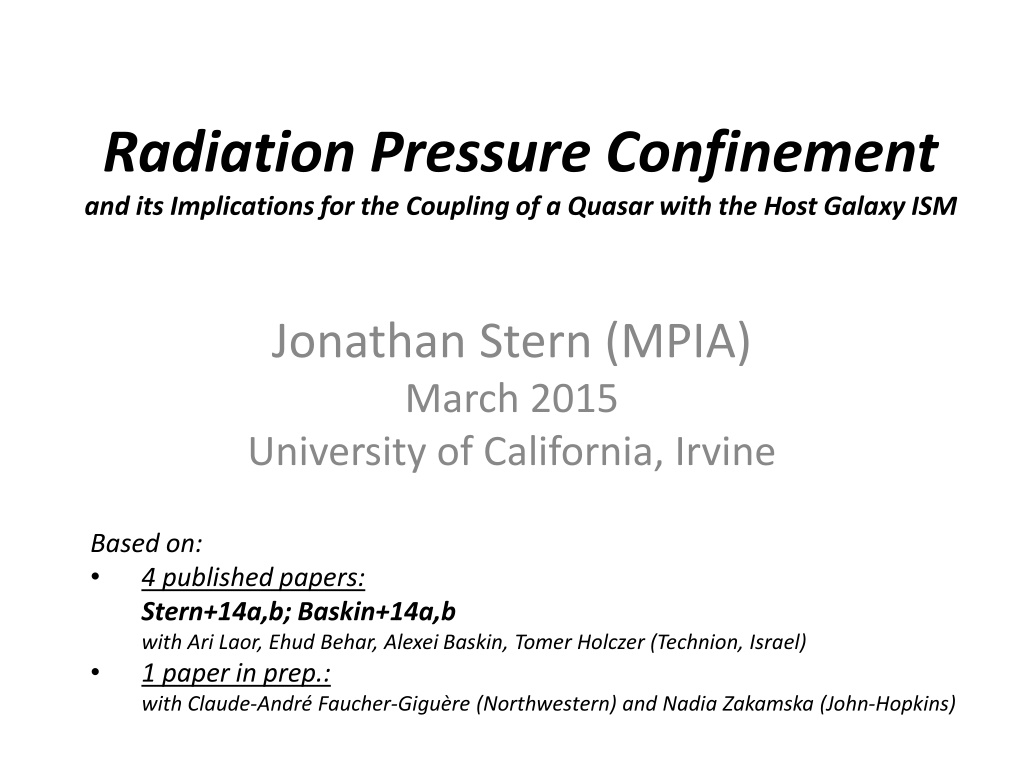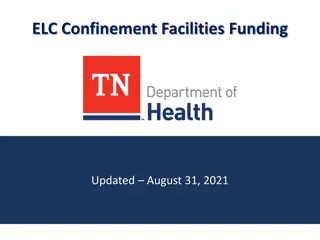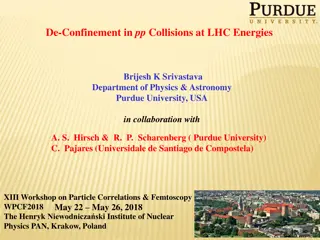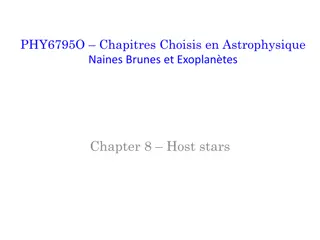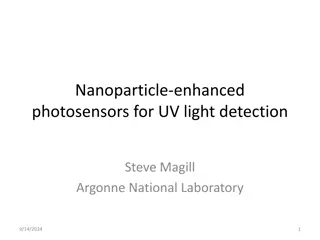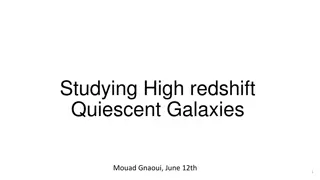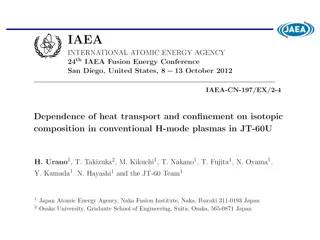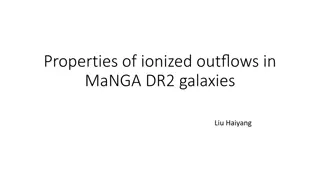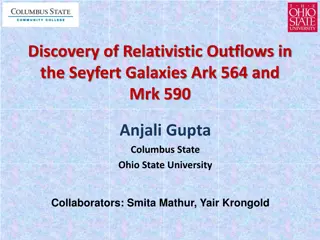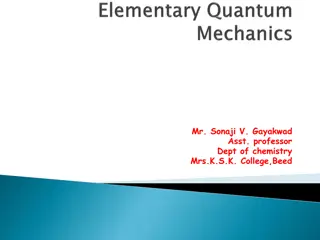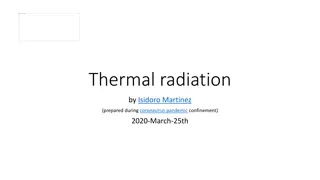Understanding Radiation Pressure Confinement in Quasars and Their Host Galaxies
Jonathan Stern's research explores the implications of radiation pressure confinement on the interaction between quasars and their host galaxies, focusing on photo-ionized gas systems. Through modeling and analyzing various properties of these systems, the study offers insights into quasar feedback models and the coupling of quasars with the interstellar medium of host galaxies.
Download Presentation

Please find below an Image/Link to download the presentation.
The content on the website is provided AS IS for your information and personal use only. It may not be sold, licensed, or shared on other websites without obtaining consent from the author. Download presentation by click this link. If you encounter any issues during the download, it is possible that the publisher has removed the file from their server.
E N D
Presentation Transcript
Radiation Pressure Confinement and its Implications for the Coupling of a Quasar with the Host Galaxy ISM Jonathan Stern (MPIA) March 2015 University of California, Irvine Based on: 4 published papers: Stern+14a,b; Baskin+14a,b with Ari Laor, Ehud Behar, Alexei Baskin, Tomer Holczer (Technion, Israel) 1 paper in prep.: with Claude-Andr Faucher-Gigu re (Northwestern) and Nadia Zakamska (John-Hopkins)
Outline 1. Intro: photo-ionized gas systems and why we model them 2. How do we model photo-ionized gas 3. A puzzle: why does the gas density depend on the flux? 4. The proposed solution Radiation Pressure Confinement 5. Implications for Quasar feedback models Jonathan Stern, MPIA 2
Photoionized Gas Systems Active Galactic Nuclei Star-Forming regions Henney+07 Jonathan Stern, MPIA 1. Intro: photo-ionized gas systems and why we model them 3
Spectral Energy Distribution Richards+06 A Short Intro to AGN Optical-UV spectrum Vanden Berk+01 H spectrum Narrow H Narrow [NII] Broad H 10,000 km/s Jonathan Stern, MPIA 1. Intro: photo-ionized gas systems and why we model them 4
Photoionized Gas Systems Active Galactic Nuclei Star-Forming regions Henney+07 Diverse Properties Gas densities: ?H 102 1011 cm 3 Photon fluxes: ?? 109 1020 cm 2s 1 Columns: optically thick / optically thin Composition: Spectrum: dusty / dust-less hard / soft Jonathan Stern, MPIA 1. Intro: photo-ionized gas systems and why we model them 5
Why model photo-ionized gas? 1. Constrain gas properties: ?,?H 2. Constrain unobservable 1 15 Ryd emission Accretion disks Hot stars Gas Metallicity 3. Constrain stellar feedback models Ionization state reflects ratio of radiation pressure (????) to pressure of expanding hot gas (????) (Yeh & Matzner 2012) HII Stellar Mass Hot gas (?hot) Tremonti+04 ?rad Jonathan Stern, MPIA 1. Intro: photo-ionized gas systems and why we model them 6
How do we Model Photoionized Gas? Parameters 1. Spectral shape (????) ?? ???) 2. Ionizing photon flux ?? (or ? 3. Gas density ?? ??,???? ?,??,?? 4. Metallicity Z 5. Column density ?H Equations Result: emission line / absorption line spectrum 1. Local Ionization Equilibrium 2. Local Temperature Equilibrium 3. Radiation Transfer Codes: CLOUDY, MAPPINGS, TITAN, XSTAR, ION, Jonathan Stern, MPIA 2. Photoionized gas models 7
A Puzzle: Small Dispersion in Line Ratios System: AGN Narrow Line Region ? Small dispersion suggests a small range in ? ?ion ? ?? ??? AGN observations Why is there a universal ?? or How does ?? know about ??? SF (? = 2) Data (type 1 AGN) from Stern+13 Jonathan Stern, MPIA 3. A puzzle 8
A Puzzle System: AGN Broad Line Region ???? ?????~ ? ?.? ?~?.? independent of ???? a range of 106 in LAGN Why is there a universal ?? or How does ?? know about ??? Dietrich+02 Jonathan Stern, MPIA 3. A puzzle 9
A Bigger Puzzle: Co-spatial X-ray Lines Image: [OIII] NGC 1386 System: AGN Narrow Line Region Contours: X-ray lines (OVII FeXXI) Greene et al. (2014) 100 pc NGC 3393 Bianchi & Guainazzi (2007) 400 pc Jonathan Stern, MPIA 3. A puzzle 10
A Bigger Puzzle: Co-spatial X-ray Lines integrated data from Bianchi+07, Greene+14 ? = 10 ? = 1 ? ? = 0.01 ? = 10 3 Inconsistent with a single-? model requires high-? and low-? `phases 2-phase models are consistent with the whole screen So why is there a constant ratio ofhigh-? ??low-? gas? Jonathan Stern, MPIA 3. A puzzle 11
A Bigger Puzzle: X-ray Lines System: AGN X-ray absorbers Column densities (??+? ??+??): X-ray Spectrum: ?ion/1016cm 2 Ion Holczer+2007, IRAS 13349+2438, 300ks HETGS Jonathan Stern, MPIA 3. A puzzle 12
A Bigger Puzzle: X-ray Lines System: AGN X-ray absorbers Column densities (??+? ??+??): ?ion/1016cm 2 Ion Behar+09 8-10(!) free parameters with const-?Hmodels So why do all objects have ?? ?log ? 1021.5?0 0.4? Jonathan Stern, MPIA 3. A puzzle 13
Mid-Summary: The Puzzle Photoionized Gas Models: Independent free parameters - ??,?? The Puzzle(BLR, NLR): ?? ?H? Optical line ratios: a dominant ? ??not independent of ?? Including X-ray lines: a universal?-distribution ?? ?log ? 1021.5?0 0.4 Jonathan Stern, MPIA 3. A puzzle 14
Possible Solution #1: LOC (Locally Optimal emitting Clouds) (Baldwin+95, Ferguson+97) The model: 1. Numerous clouds with different ?H (and ?) 2. Each line is emitted from the cloud which maximizes the line emission Explains: Preferred ?, as a selection effect Can t Explain: 1. ?? 0.01 ?? 0.01 The system has a dominant ? Constant ratio of low-?to high-?clouds 2. Jonathan Stern, MPIA 4. Possible solution 15
Possible Solution #2: Radiative Transfer + Hydrodynamics (e.g. Krumholz+13, Proga+14, Namekata+14) Highly dynamic systems hydro sims are apparently required Problems: x CPU intensive radiation transfer is approximate x Hydrodynamics more free parameters in contrast with gas uniformity Jonathan Stern, MPIA 4. Possible solution 16
The Proposed Solution: Radiation Pressure Confinement (RPC) SF: Mathews 67; Pellegrini+07,09; Draine 11; Yeh&Matzner 12 AGN: Pier&Voit 95; Dopita+02; R a ska+06; Stern+14a,b; Baskin+14a,b ?rad ? ?rad ?gas,0 1. 2. Self-gravity is negligible 3. Quasi-hydrostatic Radiation is dominant force Radiation compresses the gas. Something absorbs the momentum Jonathan Stern, MPIA 4. Possible solution 17
RPC Properties: Ionization Front ?gas= ?rad=?rad additional pressure from optical photons ? ?? ? 2?H?? = ?? (1 + ?) 1 1 ?? ?H?= 2?? ? ? 2 ?? 36eV ? 0.03 104K ??1 + ? Most of the energy absorbed (and released) a? ? 0.03 Jonathan Stern, MPIA 4. Possible solution 18
RPC Properties: The Surface Layer ?gas ,? ?H ,? alarge range of ?? and ?in a single slab Analytic solution: (Stern+14b) d? d log ? ? 0.9 (for ? > 0.03) Emission Measure Distribution: d? d log ? 1022?0.1 cm 2 Absorption Measure Distribution: Jonathan Stern, MPIA 4. Possible solution 19
RPC Models of Photo-ionized Gas Codes: CLOUDY, MAPPINGS, TITAN , XSTAR, ION, Parameters 1. Ionizing photon flux ?? ??, ?,??,?? ???????? 2. Spectral shape 3. Metallicity Z 4. Gas density ?? set by ?? ; range of ?H per slab 5. Column density ?H Result: specific emission line / absorption line spectrum Equations 1. Local Ionization Equilibrium 2. Local Temperature Equilibrium 3. Radiation Transfer 4. Hydrostatic equilibrium Jonathan Stern, MPIA 4. Possible solution 20
RPC: Comparison with Observations System: AGN Narrow Line Region RPC Models ? = 2,? = 0 constant-?H models ? = 2,?H= 1000 ? = 2,?H= 1000 constant-?H models SF (? = 2) Data (type 1 AGN) from Stern+13 RPC models from Stern+14a (see also Groves+04) Jonathan Stern, MPIA 4. Possible solution 21
RPC: Comparison with Observations System: AGN Narrow Line Region RPC Models ? = 10 ? = 1 ? = 0.1 constant-?H models models constant-?H ? = 0.01 ? = 10 3 Stern et al., in prep. Jonathan Stern, MPIA 4. Possible solution 22
RPC: Comparison with Observations d? d log ? 8x1021?0.1 cm 2 Predicted Absorption Measure Distribution: System: AGN X-ray absorbers RPC(CLOUDY) Column densities (??+? ??+??): ?ion/1016cm 2 Ion Stern+14b 8-10(!) free parameters with const-?Hmodels 0 free parameters with RPC Jonathan Stern, MPIA 4. Possible solution 23
RPC: Comparison with Observations NGC 1068 RPC predicts d? dlog? ? 0.9 d? dlog? ? 1 as observed! Ogle et al. (2003) Jonathan Stern, MPIA 4. Possible solution 25
RPC Implications: Quasar Feedback 11 ?~0.5 quasars (< 10kpc) (Liu, Zakamska, et al. 2013) [OIII]/H Soft X-ray / [OIII] (x10) Greene+14 OIII H? suggests ?rad ?other> 0.4 X ray [OIII] suggests ?rad ?other> 10 RPC limit Line ratios suggest radiation dominates quasar-ISM coupling Stern, Faucher-Gigu re, Zakamska, in prep. e.g. pressure of expanding hot gas bubble Jonathan Stern, MPIA 5. Implications 26
RPC: More Implications Constraining ????,?: One less free parameter stronger constraints (see Dopita et al. 2014) HII Molecular gas: Also in pressure equilibrium with the radiation? ?/? is not a free parameter HI,H2 ?gas= ?rad ? Jonathan Stern, MPIA 5. Implications 27
Summary Radiation Pressure Confinement Constant-?? models raise a puzzle: ?? ??? ? Why do photoionized gas systems have a dominant ? Why is the ? distribution universal? A possible solution: Radiation Pressure Confinement: pressure equilibrium with incident radiation Implications: Radiation pressure dominates coupling of quasar to host ISM Jonathan Stern, MPIA 28
Implications: Star-Forming Regions SF: no sensitivity to high-? states data Small dispersion suggests a small range ?? ??? at each Z open problem since Dopita & Evans (1986) in ? const -?? models Levesque+10 Jonathan Stern, MPIA 3. A failure of the models 29
RPC: Hydrodynamical stability Rayleigh-Taylor Illuminated side: stable. (tenuous gas above dense gas) A cloud pushed against a low density medium: unstable. (but possibly ?RT > ?sound) Hydro-simulation: (Namekata+14) Jonathan Stern, MPIA 4. Possible solution 30
(Chandra HETGS, 300ks, 6-23, FWHM=23m) Jonathan Stern, MPIA Photoionized gas 31
Jonathan Stern, MPIA Photoionized gas 32
RPC: Quasar Feedback Torus BLR NLR extended NLR reverberation (? = 1040 1047) thermalization resolved ?gas set by ?rad Gas density is set by radiation pressure at 0.01 pc - kpc Jonathan Stern, MPIA Photoionized gas 34
RPC: AGN Narrow Line Region Constant ? ?~1 ?H??~1 = 6 107?45?pc 2cm 3 a measure of gas density 45= L ( ) 4 . 0 45= L ( . 0 01 ) NGC 4151 NGC 3227 = 2 4000 nf 100 r = 2 100 nf 100 r pc pc [O I] / [SII] [O I] / [SII] 1 10 100 r (pc) Stern+14a HST data from Kraemer+00, Walsh+08 1 10 100 r (pc) [SII] 6716/6731 [SII] 6716/6731 1 10 100 r (pc) no free parameters! HST data from Kraemer+00, Walsh+08 Jonathan Stern, MPIA 4. Possible solution 35
Type 2 quasars (Liu+13) [OIII] / H 1 3 10 r (kpc)
RPC: The Surface Layer 1 d log ?= ? ? 1 ? ? d? ? 1 d log ? 104K 0.03 d log ? What are ?(?) and ?(?)? At ? = 1000, the gas is fully ionized, so ? = ?Thompson= 10 24.2cm2, ? = ?Compton= 106.5K At ? = 0.03 ? = 10 22cm2, ? = 104K Power-law interpolation (justified numerically): ? 0.03 Therefore, 0.49 0.56 ? ? ? ~10 22 cm2, ? ? ~104 K 0.03 0.05 d? ? d log ?~ 4?1021 0.03
